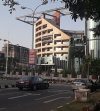According to the latest estimates, production in sub-Saharan Africa increased by 3.5% in 2021, supported by the rebound in commodity prices and the easing of social restrictions. However, the recovery remains fragile and insufficient to stem the increase in poverty caused by the pandemic, while new waves of COVID-19 pose a lingering threat.
The Omicron variant is now fueling the increase in cases across the region. More than 70% of countries in sub-Saharan Africa have reported an increase of at least 50% in the number of COVID cases in the last two weeks of 2021.
Services, tourism and manufacturing have been particularly hard hit by the pandemic, with prolonged losses of income and jobs, while inflation has dampened the recovery in consumer spending. The rise of social unrest, insecurity and internal conflicts, particularly in the Sahel region (Burkina Faso, North-East Nigeria, Niger, Mali, Mauritania and Chad) and in Ethiopia, has hampered the expenditure of ‘investment. The increase in public debt and the loss of fiscal revenues have further reduced the room for maneuver to support the recovery in the countries of the region.
Growth in the three largest economies in the region (Angola, Nigeria and South Africa) is estimated to have been revised upwards from earlier forecasts, to 3.1% in 2021.
In Angola and Nigeria, growth was driven by the recovery in the non-oil sectors. Oil production remained below pre-COVID levels due to interruptions in maintenance work and a decline in investment in extractive industries.
In South Africa, the strong economic recovery at the start of the year was disrupted by severe outbreaks of COVID-19, social unrest and power outages. Elsewhere in the region, growth in non-oil commodity exporters benefited from higher metal and food prices, while disruptions in the international travel and tourism industry continued to weigh on the economy. recovery in countries dependent on the tourism sector (Namibia, Seychelles).
For what prospects?
Growth in Sub-Saharan Africa is expected to pick up slightly over the forecast period, to 3.6% in 2022 and 3.8% in 2023. the period 2000-19, a consequence of the lingering effects of the pandemic and the reduction of aid measures, combined with public policy uncertainty and worsening insecurity in some countries.
High commodity prices are expected to support the near-term recovery in the region, with Nigeria and Angola benefiting from higher oil prices and the gradual easing of production cuts in EMEA countries. OPEC+. Growth is expected to reach 2.5% in 2022 and 2.8% in 2023 in Nigeria, while it will accelerate to 3% on average in 2022-23 in Angola. In South Africa, growth is expected to fall back to pre-pandemic levels, held back by structural impediments and the country’s heavy debt burden.
High cotton and food prices such as coffee will benefit agricultural exporters (Ethiopia, Kenya and Tanzania). In some countries, however, the expansion of agricultural activities will be limited by various uncertainties, including periods of drought and below-average rainfall, as well as the intensification of conflicts.
The pandemic has hampered progress in tackling poverty and achieving key development goals across the region, wiping out more than a decade of gains in per capita income for some countries. In more than a third of the countries in the region, including South Africa, Angola and Nigeria, per capita income in 2022 will remain below the level of a decade ago.
For what risks?
The risks weighing on these forecasts are on the downside.
Poverty, food insecurity, rising food prices and geopolitical tensions could weigh on consumer demand and dampen growth. A sharp slowdown in global economic growth could lead to significant downward corrections in commodity prices to the detriment of oil and metal producing countries. Countries facing over-indebtedness problems could find it more difficult to access external financing, which would require a sharp fiscal adjustment.
Low COVID-19 vaccination rates expose countries in the region to a resurgence and worsening of epidemic waves, which could again undermine economic activity. A prolonged pandemic risks exacerbating existing development and health challenges, stalling structural and fiscal reforms, and leading to long-lasting human capital losses.
Source The World Bank January 2022




















Réagissez à cet article